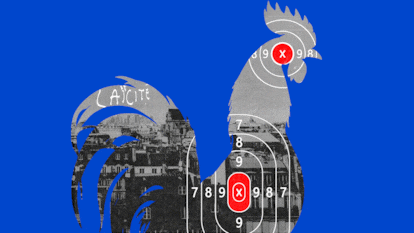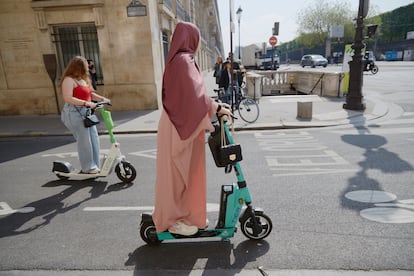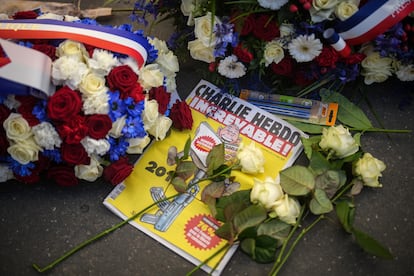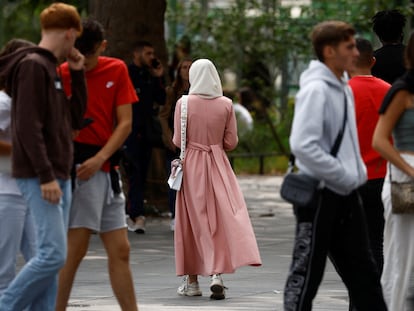France: A crisis of faith in secularism, 10 years after the ‘Charlie Hebdo’ attack
For some, a secular state is the foundation of an open society, which allows both faith and blasphemy. For others, secularism is an excuse to justify Islamophobia. The Islamist attacks of 2015 left a wound in French society that has opened up a debate on the idea of laïcité

On January 16, 2015 — nine days after the Kouachi brothers, two French-born Islamist terrorists, entered the offices of the satirical newspaper Charlie Hebdo and murdered nine of its employees — a turning point in history occurred. Charb, a charismatic cartoonist who directed the publication, was one of the victims. His funeral was held in Pontoise, northeast of Paris. Among the friends who spoke was Jean-Luc Mélenchon, the leader of the left-wing party La France Insoumise (LFI).
“You were killed by our oldest, cruelest, most constant, most obtuse enemies: religious fanatics, bloody imbeciles, who have always been shouting,” he proclaimed. He also spoke of how the French creed of “laïcité” had been “ridiculed” and how his friend had defended the “secularists” who were “mocked.” “Thank you, comrade,” he sobbed, broken.
Ten years later, everything has changed radically. Today, Mélenchon is one of the great enemies of the publication, as well as of the idea of laïcité that presided over the funeral, and which has functioned as the backbone of the Republic since 1905.
The 2015 attacks in France also included the assault on the Bataclan concert hall, where 130 people were killed, as well as a shooting at a Jewish supermarket, where four people died. The following year, 86 people were run over during a truck attack in Nice. These attacks left a wound in France, from which the idea of secularism is slowly bleeding out.
On the very same day as the massacre at Charlie Hebdo, Submission (2015), by the acclaimed novelist Michel Houellebecq, was published. The book imagines a France under the command of a Muslim president, who comes to power thanks to the support of all the parties united against the National Front (now known as the National Rally). The cover of the magazine on the day of the attacks was precisely occupied by Houellebecq’s prophecies. All of this, in essence, constituted a rift through which the French left would also begin to break up. Two “irreconcilable” universes were formed, in the words of then-prime minister Manuel Valls.
Religious symbols such as the headscarf, identity issues such as nationality (the discussion about the revocation of French citizenship should someone commit an act of terrorism has heated up) and also a multitude of everyday issues — from pork-free menus in school cafeterias, to the seat that a public bus driver could refuse to occupy if a woman had sat there, to the headscarf of a mother who’s accompanying her child on school trips as a volunteer — have been simmering in the pot of public debate for years. The only common thread was Islam. And the 2015 attacks hardened positions, especially among some sectors of the left. But how did we get to this point?
A radical law (for 1905)
The law on secularism, passed in 1905, was an expression of legal modernity that emerged from the French Revolution. It placed limits on Catholicism and on a France that the Vatican had considered to be “the eldest daughter of the Church.” It was so radical for the time that the country broke relations with the Vatican, which was frightened that some priests were being persecuted for wearing cassocks. But reality gradually accommodated a norm that helped articulate the principles of “liberty, equality and fraternity.” Laïcité — a specific concept of secularism — ended up in the first article of the French Constitution of 1946.
In a phone interview with EL PAÍS, political scientist Patrick Weil, author of De la laïcité en France (On Secularism in France), explains that “religion has two dimensions: one that’s individual and one that’s collective,” the latter of which “aims to organize society.”
A liberal democratic state,” he continues, “must respect the freedom of individuals. In reality, the law allows these two dimensions to be reconciled. The current conflict is born out of ignorance.”

The law is based on its first two articles. The first protects the right to believe, to express faith. The second maintains that religion and the state must be separated; one has the right not to believe and to blaspheme (this is the article that publications such as Charlie Hebdo have always relied on to operate). From this neutrality of the state, but also from the protection of each religion, arises the prohibition of displaying religious symbols in schools (in universities, it’s possible if students are of legal age) or by public officials. “In France, the right to worship is extremely protected,” stresses the writer Frédéric Martel, author of In the Closet of the Vatican: Power, Homosexuality, Hypocrisy (2019). “During the pandemic, the first [institutions] to reopen, before schools, were churches, mosques and synagogues.”
Canada or the UK — unlike France — believe that allowing religious expressions in public spaces favors integration. But neutrality is enforced in the French Republic, where there are more than 6.8 million Muslims, or around 10% of the population (Islam is the fastest-growing religion in France and is most widely practiced). Many countries apply a similar idea, either through laws or in their constitutions, although the level of application varies.
According to Henri Peña-Ruiz, author of, among other books, God and Marianne; Philosophy of Secularism (2011), French laïcité is neither so radical, nor so French: “It’s a myth promoted by adversaries [of the policy]. Atatürk gave women the right to vote in 1934 in a Muslim country like Turkey. He created secularism: he separated Islam and the place of worship from the state. It’s true that, today, [President] Erdogan is trying to destroy it… but in Turkey, there was secularism.” He also recalls that Thomas Jefferson, the third president of the United States, called for the creation of a wall between the church and the state, and that the Spanish Constitution maintains that “no religion shall have a state character.”
Oppression or freedom?
In 2016, a group of philosophers, professors and civil society figures — led by Laurent Bouvet, a long-time socialist activist — created the Republican Spring movement. They received support from a large sector of the Socialist Party, such as Valls himself, currently Minister of Overseas Affairs, or its current secretary general, Olivier Faure. One of the co-founders is Gilles Clavreul, France’s former interministerial delegate in the fight against racism and anti-semitism (2014-2017). He feels that giving up the defense of secularism is “a death trap” for the left.
“Islamists or decolonizers have found more and more credibility on the left. And, for those of us who were part of the Republican Spring, it seemed that what had been at the heart of the left, such as universalism [or] equality, was being erased in favor of a communitarian, decolonial interpretation, which is extraordinarily critical of democracy’s great achievements, such as freedom of expression. Today, we’re in a moment where everything is changing direction. The left wants to regulate the internet, while the right claims to be the defender of freedom of expression. It’s the world turned upside down,” Clavreul says.
The attacks on Charlie Hebdo had another consequence that further hardened the debate. On Friday, October 16, 2020, a man armed with a knife appeared in the middle of the afternoon in front of the Collège du Bois-D’Aulne, in Conflans-Sainte-Honorine, a municipality of 35,000 inhabitants northwest of Paris. First, he asked the students about Samuel Paty, a teacher. He then followed Paty in the direction of his home. The man, an 18-year-old of Chechen descent, attacked him with the knife and ultimately decapitated him. Then, he photographed the corpse and uploaded the image to Twitter (now X) with a message addressed to “[President] Macron, leader of the infidels.” He added: “I have executed one of your dogs [from] hell who dared to degrade [the Prophet] Muhammad.”
What was the reason for this attack? Days earlier, the teacher had shown some caricatures of the Prophet Muhammad to his class and had talked about Charlie Hebdo. A Muslim student told their father about the incident, who subsequently informed a fundamentalist preacher. Lies and a digital hate campaign began to spread.
The wound was bleeding again. And Macron — as is his custom in solemn moments — delivered an emotional speech on the day of Paty’s state funeral, so as to evoke the sacred value of secularism in France. “We will continue, professor, this fight for freedom and reason, of which you are now the face. Because in France, professor, the lights never go out,” he promised, referring to reason and the Enlightenment. “We will defend secularism and the freedom that you taught so well. We will not give up caricatures or illustrations.”
However, there’s a significant portion of the left in France that sees this old principle as a form of oppression against Muslims. This has placed the founding idea largely in the hands of the right. The philosopher Henri Peña-Ruiz believes that there’s a great threat to this secular principle, but that it’s not challenged by the majority. “To say that it’s a way of stigmatizing part of the population is nonsense: it’s just the opposite,” he argues. He claims that it has allowed France to receive “people who come from very varied traditions, [not just from] the dominant religions, such as Islam, Judaism, or Catholicism.” In his opinion, “the problem comes from the Islamists, who seek to impose their conception of religion.” And he adds that “a part of the left has a compassionate vision of Muslims, as if they were poor people who are being persecuted. Of course, there is racism [directed against them]… but not from the majority of the population.”
The Left Turn
On January 11, 2015, the largest demonstration in France since liberation swept across the country. Four days after the Islamist massacre on January 7 that decimated part of the Charlie Hebdo editorial staff, more than four million people marched while carrying signs that read “Je suis Charlie.” But the protests also highlighted a huge problem: who the hell was Charlie?

Many sociologists and political scientists noted that, among these four million people, there were youngsters from les banlieue (the suburbs), often marginalized Muslims. But demographer Emmanuel Todd summed it up differently in his book, Who is Charlie? (2015): “Millions of French people took to the streets to define the right to spit on the religion of a weak minority in France” as a “priority” for their society.
Mélenchon ultimately missed out on the second round of the 2017 presidential elections by some 600,000 votes. So, he decided to look for them among the youth and the working-class neighborhoods, where a large part of French citizens of Middle Eastern and North African origin live. Many of his new legislators — elected in the 2024 elections — come from these districts.
Martel analyzes what he considers to be the electoral reasoning behind this pivot: “Mélenchon thought that the voters on the left had become the well-off classes and that it was very difficult to speak to the working-class people. So, he looked at the [electoral] map and realized that those who are currently in charge of cleaning, delivering food, working in factories, or those who are unemployed, are, essentially, second or first-generation immigrants. He had to address them, but he didn’t have many topics: [declining] purchasing power, criticism of Israel… and, of course, criticism of how secularism has turned into Islamophobia and discrimination.”
The idea caught on. And, a certain part of the left tuned into this discourse. But why?
Jean Baubérot, a sociologist and historian who specializes in religions, adds context during a phone interview with EL PAÍS: “What’s oppressive is to focus only on secularism with respect to Islam. And people — generally those on the right — have a very different position on this issue with respect to Catholicism, like the [conservative] minister of the Interior, Bruno Retailleau. There’s a left that mobilizes against this, against the inequality in the application of this secularism. Banning the veil for mothers who go to pick up their children from school, as Retailleau has demanded, goes against secularism. Spaces that don’t represent the state are places of freedom of conscience: the Council of State dictates this. And this [part of the] left fights against the perversion of the concept of secularism, which hides an anti-Muslim tendency and would like to make Catholicism the national religion again.”
Member of Parliament Farida Amrani, who belongs to La France Insoumise, shares this idea. A Muslim who was born in Morocco 48 years ago, she believes that “the values of laïcité consisted in emphasizing that we are all equal, in order to live together in peace. Religion should be kept in the private sphere and the state couldn’t interfere in the beliefs of individuals. The secular school, which made me what I am today, was like that. But since the [Charlie Hebdo] attacks — even a little before that — there’s been a deviation from this principle. Today, [laïcité] is an instrument of Islamophobia. For [those in power], when they talk about secularism, it’s simply to stigmatize Muslims. It’s not applied to anyone else with that severity.”
But the theory of Islamophobia isn’t a dogma shared by all Muslim politicians in France. Karim Bouamrane, the socialist mayor of Saint-Ouen, one of the Parisian suburbs, defends a more nuanced view in a telephone conversation with this newspaper: “Secularism is often confused with Islamophobia. And that began to happen with the 2001 attacks in New York. The National Front saw it as an opportunity to find a scapegoat. And the consequence of that — instead of putting the united and indivisible Republic first — was the attempt to separate people based on their religious affiliation. The first were the Muslims, just as the Jews had been before.” In his opinion, this produced “an identity-based closing of ranks” and “a fear of the principle of laïcité.”
The result is a bitter cocktail of doubts, mistrust and resentment. It stings like salt in the wound that opened 10 years ago in France. Martel sums it up this way: “For many Muslims, it’s difficult to understand laïcité. Unlike secularism — which is very clear — it’s more complex. Many wonder why homophobic or anti-women speech is prohibited. And why are you punished if you’re anti-semitic but, on the other hand, you’re allowed to criticize the Prophet and mock him? People in the banlieues don’t understand this. There are head teachers who explain that some pupils ask them why they’re honoring Samuel Paty and not the victims in Gaza. And it’s very difficult to explain. The answer, of course, is that Gaza isn’t France… but it creates a movement of hostility and comparative grievance that’s difficult to manage.” Perhaps just as difficult as the abstract idea that “all of France is Charlie” from 10 years ago, when some French people began to lose faith in secularism.
Sign up for our weekly newsletter to get more English-language news coverage from EL PAÍS USA Edition
Tu suscripción se está usando en otro dispositivo
¿Quieres añadir otro usuario a tu suscripción?
Si continúas leyendo en este dispositivo, no se podrá leer en el otro.
FlechaTu suscripción se está usando en otro dispositivo y solo puedes acceder a EL PAÍS desde un dispositivo a la vez.
Si quieres compartir tu cuenta, cambia tu suscripción a la modalidad Premium, así podrás añadir otro usuario. Cada uno accederá con su propia cuenta de email, lo que os permitirá personalizar vuestra experiencia en EL PAÍS.
¿Tienes una suscripción de empresa? Accede aquí para contratar más cuentas.
En el caso de no saber quién está usando tu cuenta, te recomendamos cambiar tu contraseña aquí.
Si decides continuar compartiendo tu cuenta, este mensaje se mostrará en tu dispositivo y en el de la otra persona que está usando tu cuenta de forma indefinida, afectando a tu experiencia de lectura. Puedes consultar aquí los términos y condiciones de la suscripción digital.
More information
Archived In
Últimas noticias
The late consecration of women artists in their 90s
The Florida Keys tourist paradise is besieged by immigration agents: ‘We’ve never seen anything like this’
The latest scam on WhatsApp behind the legal dream: using immigration status as bait
Oil, gold and rare earth elements: the backdrop to US political tension with Venezuela
Most viewed
- Families demand repatriation of bodies of Colombians who died in Ukraine: ‘This war is a slaughterhouse for foreigners’
- The low-cost creative revolution: How technology is making art accessible to everyone
- Liset Menéndez de la Prida, neuroscientist: ‘It’s not normal to constantly seek pleasure; it’s important to be bored, to be calm’
- Christian Louboutin: ‘Young people don’t want to be like their parents. And if their parents wear sneakers, they’re going to look for something else’
- ‘El Limones’ and the growing union disguise of Mexican organized crime










































